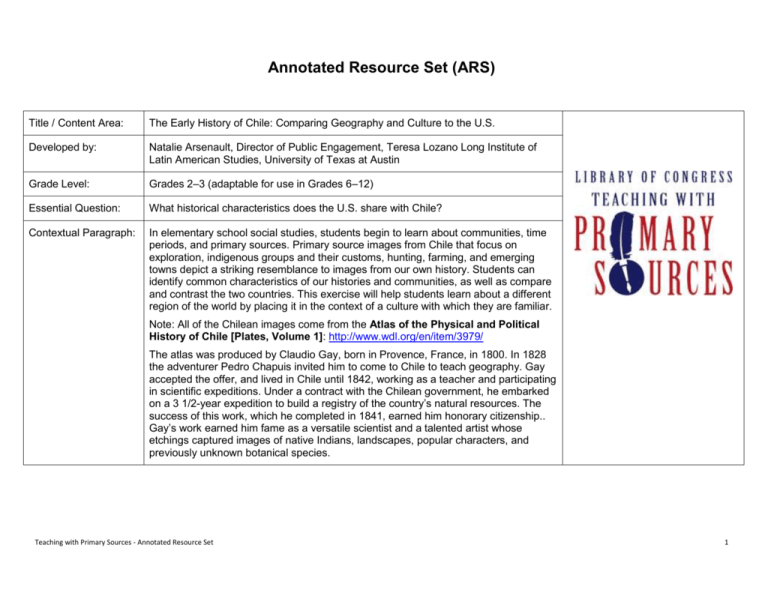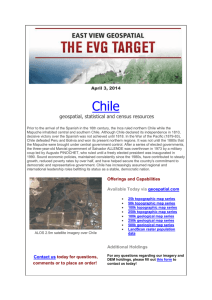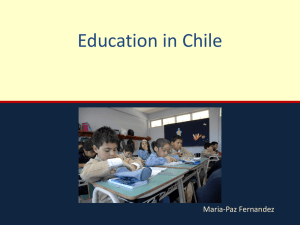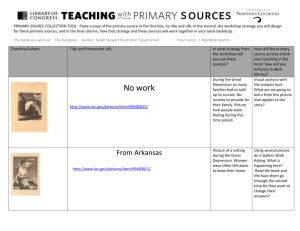WikiCurriculum - The University of Texas at Austin
advertisement

Annotated Resource Set (ARS) Title / Content Area: The Early History of Chile: Comparing Geography and Culture to the U.S. Developed by: Natalie Arsenault, Director of Public Engagement, Teresa Lozano Long Institute of Latin American Studies, University of Texas at Austin Grade Level: Grades 2–3 (adaptable for use in Grades 6–12) Essential Question: What historical characteristics does the U.S. share with Chile? Contextual Paragraph: In elementary school social studies, students begin to learn about communities, time periods, and primary sources. Primary source images from Chile that focus on exploration, indigenous groups and their customs, hunting, farming, and emerging towns depict a striking resemblance to images from our own history. Students can identify common characteristics of our histories and communities, as well as compare and contrast the two countries. This exercise will help students learn about a different region of the world by placing it in the context of a culture with which they are familiar. Note: All of the Chilean images come from the Atlas of the Physical and Political History of Chile [Plates, Volume 1]: http://www.wdl.org/en/item/3979/ The atlas was produced by Claudio Gay, born in Provence, France, in 1800. In 1828 the adventurer Pedro Chapuis invited him to come to Chile to teach geography. Gay accepted the offer, and lived in Chile until 1842, working as a teacher and participating in scientific expeditions. Under a contract with the Chilean government, he embarked on a 3 1/2-year expedition to build a registry of the country’s natural resources. The success of this work, which he completed in 1841, earned him honorary citizenship.. Gay’s work earned him fame as a versatile scientist and a talented artist whose etchings captured images of native Indians, landscapes, popular characters, and previously unknown botanical species. Teaching with Primary Sources - Annotated Resource Set 1 Resource Set Burial of Cacique Cathiji in Guanegue, May 1835 A Machitún (Ceremony to Cure the Sick) Araucanians (Mapuche) Game of Chueca among the Araucanians Valparaíso Santiago Burial of indigenous leader among the Araucanian (Mapuche) people Ceremony presided over by a Mapuche shaman, the key figure who dealt with healing Portrait of indigenous people of northern Chile A Mapuche game played with clubs and a wooden ball. Chueca is the Spanish name for the game; the Mapuche call it Palín. View of Valparaíso, on Chile’s coast; the Spanish arrived here in 1536, but it remained a small village until Chile’s independence from Spain, when it became a major port Santiago, now the capital of Chile, was founded in 1541 http://www.wdl.org/en/ http://www.wdl.org/en/ http://www.wdl.org/en/ http://www.wdl.org/en/ http://www.wdl.org/en/ http://www.wdl.org/en/ item/3979/zoom/#grou item/3979/zoom/#grou item/3979/zoom/#grou item/3979/zoom/#grou item/3979/zoom/#grou item/3979/zoom/#grou p=1&page=32 p=1&page=34 p=1&page=36 p=1&page=37 p=1&page=38 p=1&page=40 Teaching with Primary Sources - Annotated Resource Set 2 View of the San Fernando Volcano, lion hunting guanacos Aculeu Lagoon The Pines of Nahuelbuta, Birth Laja Falls Road from Valparaíso to Santiago Cogoti, 1837 Chile has hundreds of active and dormant volcanoes Cowboy on lagoon south of Santiago, now a popular tourist destination for water sports and outdoor activities Mapuche people in northern Chile; Nahuelbuta is now a national park Waterfalls in southcentral Chile, with a narrow canyon It took two days to complete the trip on horse Central Chile http://www.wdl.org/en/ http://www.wdl.org/en/ http://www.wdl.org/en/ http://www.wdl.org/en/ http://www.wdl.org/en/ http://www.wdl.org/en/ item/3979/zoom/#grou item/3979/zoom/#grou item/3979/zoom/#grou item/3979/zoom/#grou item/3979/zoom/#grou item/3979/zoom/#grou p=1&page=82 p=1&page=44 p=1&page=47 p=1&page=51 p=1&page=58 p=1&page=72 Notes/Comments: http://www.treasurenet.com/images/ http://www.treasurenet.com/images/americanwest/WEST134.JPG Teaching with Primary Sources - Annotated Resource Set 3 Condor Hunt Guanaco Hunt La Cañada Path, Santiago Dance in the Government House (Casa del Gobierno), Anniversary of Independence (Sep. 18) Death of the Sioux Chief Crazy Horse, Nebraska, Medicine Man Administering to a Patient Traditional condor hunt. A cow or horse is killed and left in a closed area to attract the condor. The hunters let it eat, so that it’s weighed down. They then leave their hiding place, and when the hunters are close, they lasso or throw a net on the condor. Guanacos, members of the camelid family, are native to the Andes. They’ve been hunted since pre-Colombian times; here they are hunted on horseback. Park in the capital city Independence was gained in 1810; this celebration is from 1854 Sioux men and women follow Crazy Horse's body, wrapped in cloth and tied to a travois, en route to the grave site near Camp Sheridan, Nebraska. A Sioux medicine man sits inside a tepee attending to a patient who lies next to him covered with a buffalo hide. The medicine man looks skyward while holding a rattle in his hand. A pipe is near his feet. http://www.wdl.org/en/ http://www.wdl.org/en/ http://www.wdl.org/en/ http://www.wdl.org/en/ http://cdm15330.conte item/3979/zoom/#grou item/3979/zoom/#grou item/3979/zoom/#grou item/3979/zoom/#grou ntdm.oclc.org/cdm/singl p=1&page=61 p=1&page=62 p=1&page=52 p=1&page=66 eitem/collection/p1533 0coll22/id/38391/rec/3 http://cdm15330.conte ntdm.oclc.org/cdm/ref/ collection/p15330coll22 /id/38395 Teaching with Primary Sources - Annotated Resource Set 4 Ute Indians Ball games San Francisco, 1851 City of Austin, the new capital of Texas in January 1, 1840 Elk and Buffalo Making Acquaintance, Texas Ute man wearing beaded moccasins, fringed leggings, hide shawl, and beaded headband with feathers. A large group of Sioux men and women carry sticks and play a ball game. View of the port An early view of the city of Austin, looking north across the Colorado River. President Lamar's house is on the right at the top of the hill and the temporary capitol is at the top left. This hand-colored lithograph was based sketch by Edward Hall, a purchasing agent for the Republic of Texas. George Catlin Born: Wilkes-Barre, PA 1796 Died: Jersey City, NJ 1872 http://cdm15330.conte ntdm.oclc.org/cdm/ref/ collection/p15330coll22 /id/23367 http://cdm15330.conte ntdm.oclc.org/cdm/singl eitem/collection/p1533 0coll22/id/35633/rec/1 Teaching with Primary Sources - Annotated Resource Set http://hdl.loc.gov/loc.p np/cph.3g07421 http://www.cah.utexas. edu/exhibits/TexasExhib it/large/cityof.htm "The long detaching rings again writhed in mid-air, and softly descended as he thundered past" Wood engraving from Harper’s Weekly, 1885 oil on canvas 19 5/8 x 27 1/2 in.Smithsonian American Art Museum Gift of Mrs. Joseph Harrison, Jr. http://americanart.si.ed u/collections/search/art work/?id=4048 http://hdl.loc.gov/loc.p np/cph.3c26054 5 Villa of Brule Crossing the Platte A Lakota tipi camp near Pine Ridge, in background; horses at White Clay Creek watering hole, in the foreground. Ca. 1891. Wood engraving of a wagon train crossing the river, 1859. From Harper’s Weekly. http://hdl.loc.gov/loc.p np/ppmsc.02507 http://hdl.loc.gov/loc.p np/cph.3a49253 Teaching with Primary Sources - Annotated Resource Set Ox train used to transport supplies to Arizona Territory, 1883 http://commons.wikime dia.org/wiki/File:Ox_trai n_used_to_transport_s upplies_in_Arizona_Terr itory,_1883_-_NARA__530930.jpg A View on the Mohawk River Hunting on the Plains Bear Hunting: close quarters Print shows view of mountains and farmland along the Mohawk River. 1793 Man on horseback with rifle riding next to bison. 1871. Bison hunting was a traditional activity of the native groups on the plains, and later taken up by new settlers. Lithograph, 1850–1910 http://hdl.loc.gov/loc.p np/cph.3a32336 http://hdl.loc.gov/loc.p np/cph.3b50509 http://hdl.loc.gov/loc.p np/cph.3b49876 6 Central Park, the drive A Presidential Reception at the White House, Washington Lithograph from 1862 Illustration from Harper’s Weekly, 1858 http://hdl.loc.gov/loc.p np/cph.3a04850 http://hdl.loc.gov/loc.p np/cph.3a04850 Foundations Annotations Curriculum Connections Social Studies: World Cultures, World History, World Geography, U.S. History Curriculum Standards Texas Essential Knowledge and Skills §113.13. Social Studies, Grade 2 (2) History. The student understands the concepts of time and chronology. The student is expected to: (A) describe the order of events by using designations of time periods such as historical and present times; (B) apply vocabulary related to chronology, including past, present, and future. (3) History. The student understands how various sources provide information about the past and present. The student is expected to: (A) identify several sources of information about a given period or event such as reference materials, biographies, newspapers, and electronic sources; and (B) describe various evidence of the same time period using primary sources such as photographs, journals, and interviews. Teaching with Primary Sources - Annotated Resource Set 7 (6) Geography. The student understands the locations and characteristics of places and regions in the community, state, and nation. The student is expected to: (C) examine information from various sources about places and regions. (7) Geography. The student understands how physical characteristics of places and regions affect people's activities and settlement patterns. The student is expected to: (B) describe how natural resources and natural hazards affect activities and settlement patterns; (C) explain how people depend on the physical environment and natural resources to meet basic needs; and (D) identify the characteristics of different communities, including urban, suburban, and rural, and how they affect activities and settlement patterns. (15) Culture. The student understands the significance of works of art in the local community. The student is expected to: (A) identify selected stories, poems, statues, paintings, and other examples of the local cultural heritage; and (B) explain the significance of selected stories, poems, statues, paintings, and other examples of the local cultural heritage. (18) Social studies skills. The student applies critical-thinking skills to organize and use information acquired from a variety of valid sources, including electronic technology. The student is expected to: (B) obtain information about a topic using a variety of valid visual sources such as pictures, maps, electronic sources, literature, reference sources, and artifacts; (D) sequence and categorize information; and (E) interpret oral, visual, and print material by identifying the main idea, predicting, and comparing and contrasting. §113.14. Social Studies, Grade 3 (3) History. The student understands the concepts of time and chronology. The student is expected to: (A) use vocabulary related to chronology, including past, present, and future times; (C) apply the terms year, decade, and century to describe historical times. (4) Geography. The student understands how humans adapt to variations in the physical environment. The student is expected to: (B) identify and compare how people in different communities adapt to or modify the physical environment in which they live such as deserts, mountains, wetlands, and plains; (D) describe the effects of human processes such as building new homes, conservation, and pollution in shaping the landscape; and (E) identify and compare the human characteristics of various regions. (17) Social studies skills. The student applies critical-thinking skills to organize and use information acquired from a variety of valid sources, including electronic technology. The student is expected to: (A) research information, including historical and current events, and geographic data, about the community and world, using a variety of valid print, oral, visual, and Internet resources; (B) sequence and categorize information; (C) interpret oral, visual, and print material by identifying the main idea, distinguishing between fact and opinion, identifying cause and effect, and comparing and contrasting; (E) interpret and create visuals, including graphs, charts, tables, timelines, illustrations, and maps. Content & Thinking Objectives Content Objective 1: Students will describe aspects of Chilean geography and history. Objective 2: Students will identify common traits in Chilean and U.S. geography and history. Thinking Objective 1: Students will analyze historical images in order to describe geographic, economic, and cultural traits in Chile and the United States. Objective 2: Students will compare and contrast the geographies and histories of Chile and the U.S. Teaching with Primary Sources - Annotated Resource Set 8 Inquiry Activities & Strategies Begin with the images of Chile, but do not provide background information to students. Discuss images either in small groups or as a class (with images projected on screen). Have students observe the image and describe it. Look specifically at the geography and describe what they see (mountains, trees, volcanoes, etc.). Have them do the same for the people. What are they doing? Why? Have students address the following: How has the scene you see been affected by human activities? How might these activities affect the environment of the place? What brings people to the place in the image? What do you think these people are thinking? Ask students to guess the location and time period of these images, and to explain their answers. Do these images seem familiar (i.e., do they remind us of images from our history)? If so, why? Explain that the images are from Chile and give students a brief overview of Chile’s history. Divide students into small groups. Provide each group with a Chilean image and its companion image from the U.S. (the images are in the same sequential order in this resource set and each Chilean images has an American companion). Have students address: What is the same? What is different? What questions do they have about what they see? How can we find more information that will help us to understand these images better? Assessment Strategies Ask students to create a short story about one of the images (either Chilean or American) they analyzed. They should incorporate what they learned about geography and history. Have students research the answer to one of their questions (e.g., what is a guanaco?; why did people hunt buffalo?) and write a short report on that topic. As a class, create a Venn diagram comparing Chile and the U.S. Other Resources Web Resources Spanish blog about the burial of Cacique Cathiji: http://culturalanco.blogspot.com/2011/02/entierro-del-cacique-cathiji.html Website about the Mapuche: http://www.bariloche.com.ar/museo/MAPUING.HTM Brief article, in Spanish, about the Claudio Gay’s work in Chile: http://apc.ubiobio.cl/noticias/view_vistas.shtml?cmd[18]=i-268b57eef8fcaeab62aafc5b8a173192c3 TIME for Kids, Chile Timeline: http://www.timeforkids.com/destination/chile; http://www.timeforkids.com/destination/chile/history-timeline National Geographic Kids, Chile: http://kids.nationalgeographic.com/kids/places/find/chile/ Teaching with Primary Sources - Annotated Resource Set 9








